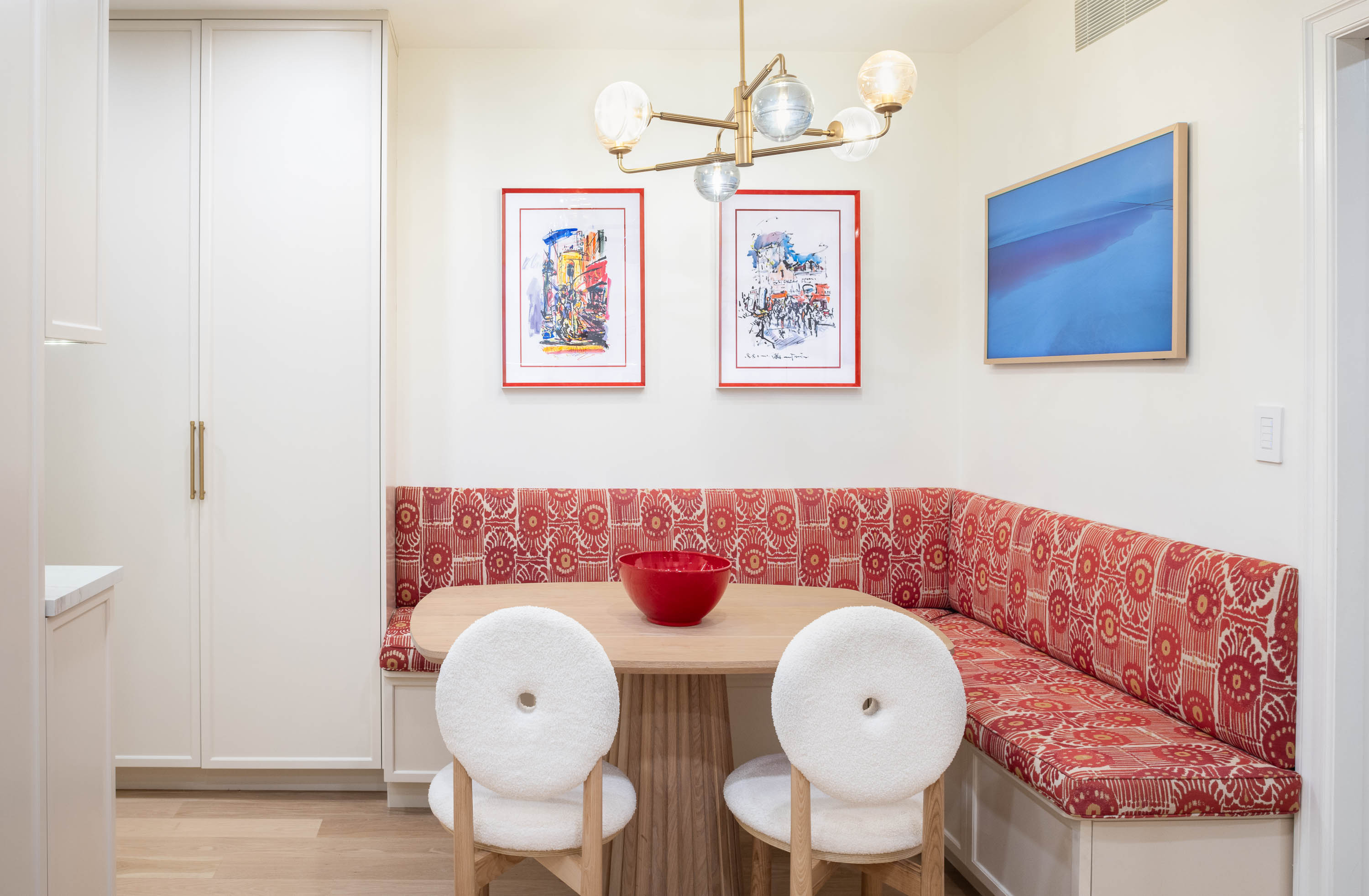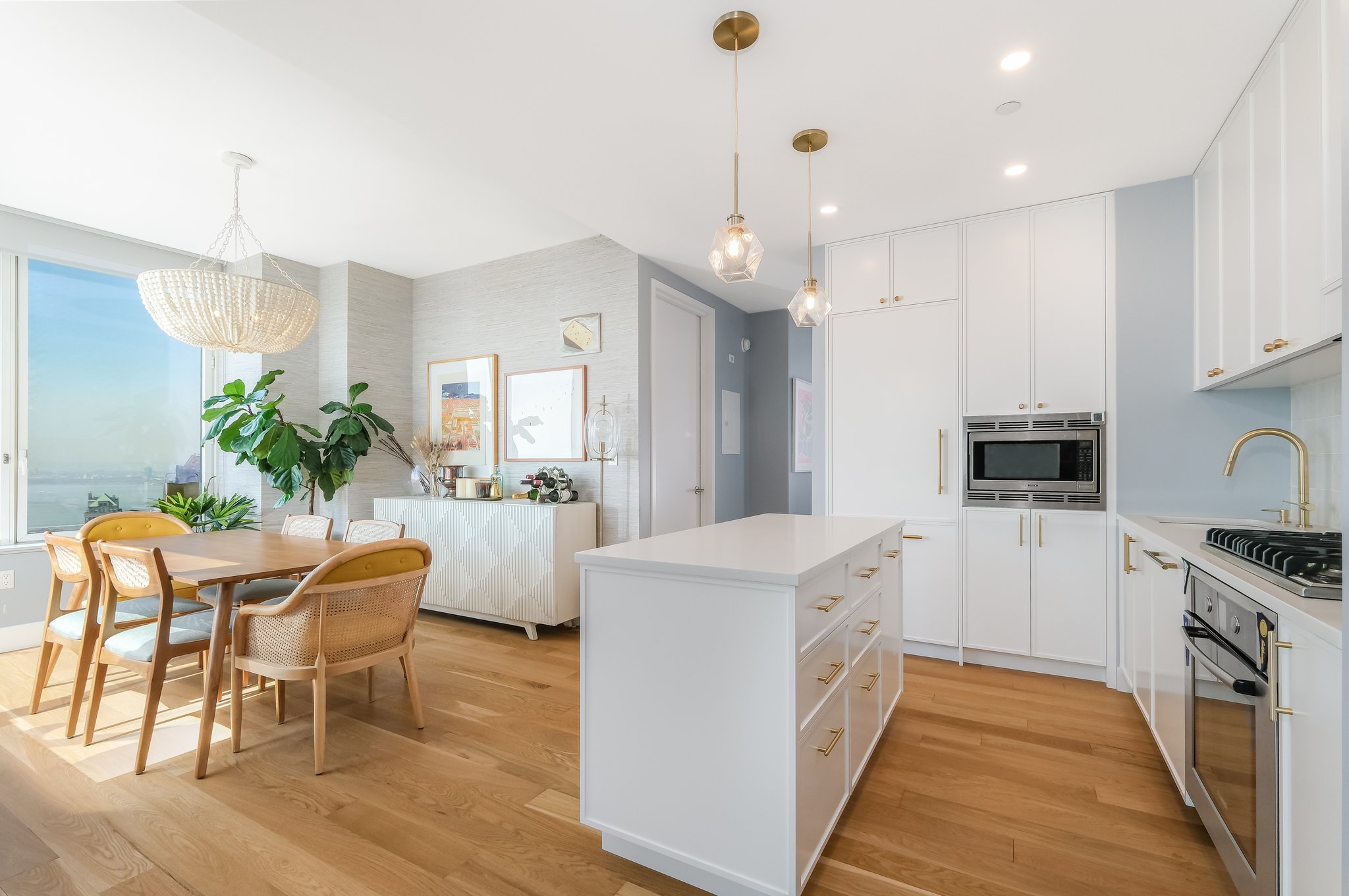30 Essential Tips for Navigating an NYC Renovation
Explore 30 expert tips for planning and managing NYC apartment renovations, with insights on design, budgeting, and approvals from real design-build pros.
November 1, 2025
|

30 Essential Tips for Navigating an NYC Renovation
Renovating in New York City is never simple, but with the right plan and partner, the city’s biggest challenges can become your greatest advantage.
Table of contents
- Tips 01 - 07: Before You Build: Strategic Planning for a Smooth NYC Renovation
- Tips 08 - 11: Navigating Approvals, Permits & Building Politics
- Tips 12 - 19: Designing With Purpose: Smart Decisions That Shape Your Space
- Tips 20 - 25: Construction In Motion: Managing Logistics, Layouts & On The Spot Decisions
- Tips 26 - 30: Budgeting, Bidding & Contractor Vetting
If you’re living in NYC, you already know nothing here comes easy. Renovations are no exception. Between the aging infrastructure, relentless regulations, and the politics of shared walls, even the smallest upgrade can feel like a full-time job. But when planned accordingly, that complexity becomes an advantage. With the right foresight, design strategy, and renovation partner, the same challenges that derail most projects can actually set yours apart.
The following insights are based on real-world lessons from the design-build trenches into tangible guidance that saves you time, money, and frustration. From early planning and board approvals to construction details and finishing decisions, consider this your blueprint for navigating NYC’s renovation maze with confidence, precision, and purpose.

[#1]Before You Build: Strategic Planning for a Smooth NYC Renovation[#1]
Every successful NYC renovation starts way before demo day. From understanding a property’s potential to aligning your timeline and budget with city-specific realities, proper prep is what separates seamless transformations from costly headaches. These tips will help you lay the groundwork for your NYC renovation, so once construction begins, every decision is informed, intentional, and built for success.
Tip 1: Schedule A Pre-Purchase Renovation Consult Before buying
Before falling in love with a property’s potential, confirm your dream home renovation is actually possible. A pre-purchase renovation consultation can reveal critical factors, such as structural wall restrictions, outdated electrical systems, or building limitations. Every one of those can make your vision impossible or far more expensive than anticipated. Identifying these issues early not only prevents six-figure mistakes but can also give you leverage to negotiate to your advantage before close. Get more details on the topic from our article, The Pre-Closing Renovation Step That Changes Everything.
Tip 2: Don’t Call An Architect Before You Know If You Need One
Many NYC homeowners waste time hiring an architect before confirming if their renovation even requires formal architectural plans. Before making costly assumptions, get clarity on your project scope first. If you’re not moving walls, plumbing, or layouts, you likely don’t need one. For projects that do, a design-build firm can handle architectural filings in-house, saving you from managing separate contracts and competing timelines. Consider the hire further with help from our blog, Do I Need To Hire An Architect For My NYC Renovation?
Tip 3: Renovation Timelines are 6–12 Months, Not 6–12 Weeks
Even a properly planned NYC renovation takes longer than most expect. Between board approvals, DOB filings, management reviews, and custom material lead times, a full apartment renovation typically spans 6 to 12 months from closing to completion. Building this reality into your purchase and move-in plans prevents costly overlap with leases, temporary housing, and extra mortgage payments. Get a further timeline breakdown via our blog, How Does A Buyer Gauge The Timeline For A NYC Renovation?

Tip 4: Plan The Renovation Around Your Schedule, Not The City’s
Between board approvals, holiday shutdowns, elevator schedules, and reviewing architect discrepancy, each building in NYC beats to its own drum. The key to not letting those nuances derail your renovation is setting proper expectations and finding the right level of support. As a design-build firm, Gallery manages every approval, submission, and schedule detail to align with your timeline. By planning around built-in pauses from the start, we keep your renovation moving smoothly, no matter the address. Consider more timing variables via Best Time To Renovate? 8 Factors To Consider When Planning A Renovation In NYC.
Tip 5: Consider Your Neighbors (And How Loud They Can Be)
In NYC, neighboring units are literally surrounding you. While you’d like to imagine you’ll have neighbors that are quiet and reserved, you can’t always account for their dog. Or their kids. Or anything, for that matter. To prevent consistent unwanted noise after you’ve settled into your newly-renovated home, consider soundproofing. Soundproofing ensures your home is closed off from any surrounding madness, especially when installed with intent and proper strategy. Watch above as Avi explains our extremely thorough soundproofing techniques live from a condo renovation in Williamsburg.
Tip 6: A Fixer-Upper Offers The Best Long-Term Value, But Only If You Budget Beyond The Purchase Price
In Manhattan, a fixer-upper can deliver massive value compared to a turnkey apartment—but only when buyers consider all angles up front. Beyond the sale price and renovation costs, owners should prepare for months of approvals and therefore, subsequent carrying costs and any fees associated with alternative housing. The smart move is to budget 20–25% beyond renovation estimates to cover these soft costs, ensuring the project stays profitable and stress-free while still unlocking potential value. Assess further with help from a real life comparison via our popular blog, Cost Comparison: Buying A Turnkey Apartment VS Renovating A Fixer Upper In Manhattan.
Tip 7: Add A 20–30% Contingency Budget For Renovations In Older NYC Buildings
Even the best-planned NYC renovations can reveal surprises once work begins, especially in pre-war buildings. In these timeless NYC addresses, outdated wiring, asbestos, or structural quirks often hide behind the walls. The best safeguard is working with a renovation partner who anticipates these issues during pre-construction and builds potential costs into your initial scope of work. A design-build firm like Gallery identifies likely problem areas early through detailed inspections and vast experience in many types of older buildings. For additional peace of mind, set aside a 20–30% contingency budget to cover any truly unexpected findings without disrupting your timeline or design goals. Learn more about the hidden costs of pre-war renovations via Pre-War Apartment Renovation: The Picturesque Pros and Real-Life Cons.
.jpg)
[#2]Navigating Approvals, Permits & Building Politics[#2]
In NYC. even the most rigid renovation plans can grind to a halt without the right paperwork, approvals, and relationships in place. From Department of Buildings filings to co-op board politics, success depends on strategy as much as design. These tips below outline how to align your plans with the city’s rules, and how the right renovation partner can keep your project moving forward while handling red tape on your behalf.
Tip 8: Pair Design With Compliance From the Start
NYC’s approval process doesn’t make many exceptions, so if you design first and permit later, expect your project to stall before demolition begins. When design, architecture, and compliance are handled separately, small oversights (like a misplaced wall or noncompliant plumbing reroute) can send your plans back to the Department of Buildings for revisions, delaying your project by weeks or even months. However, when you partner with a full-service design-build firm, those details are coordinated in real time. The same team designing your kitchen layout is also ensuring every element meets DOB and board requirements, so by the time your plans are submitted, they’re not just beautiful, they’re already approval-ready. Get more Tips To Ensure A Smooth Building Permit Approval Process For New York City Renovations.
Tip 9: Have Your Contractor Review the Alteration Agreement Early
One of the best ways to prevent gut-punch delays is finding a qualified design-build firm who will review your alteration agreement at the start of planning (not a few weeks before construction), so they can identify any restrictions and adjust timelines, coverage, or logistics accordingly. This single early step can save months of back-and-forth with management and keep your renovation on schedule. Consider all angles with help from our article, NYC Alteration Agreements: Everything You Need To Know.
-min.jpeg)
Tip 10: Choose A Renovation Partner Who Manages Building Relations
In NYC apartment renovations, respectful communication with your building’s management, super, and neighbors is essential. A good full-service renovation partner will handle this entire process on your behalf, from submitting tenant notices and scheduling elevator use to coordinating deliveries and hallway protections. This proactive management not only prevents project delays and friction, but also preserves your reputation with neighbors. Get more advice on building best-practices when renovating via our blog, Politics & Etiquette In NYC Apartment Renovations: What To Know & Why They Matter.
Tip 11: Choose a Contractor Who Plans for the Unexpected
Every NYC renovation, especially in pre-war buildings, uncovers surprises once walls are opened. This typically means outdated wiring, asbestos, or hidden plumbing. The difference between a smooth recovery and a budget blunder comes down to how your contractor plans for (and communicates) those surprises. While unfit partners may stumble, a truly experienced contractor will explain their process for cost assessment, building coordination, and next steps. A design-build firm like Gallery goes further by flagging likely problem areas during pre-construction, allowing contingency planning before demo even starts. Prepare further by arming yourself with 10 Questions To Ask A NYC General Contractor Before Hiring.

[#3]Designing With Purpose: Smart Decisions That Shape Your Space[#3]
Every great NYC renovation starts with design decisions that both look beautiful and function flawlessly. From the layout of your kitchen to the materials that define your bathroom, every choice you make should make sense from all angles. The following tips reveal how thoughtful planning, material selection, and customization can transform tight footprints and historic hang-ups into cohesive, high-performing spaces built around your lifestyle.
Tip 12: Consider How Tile Choices Can Dictate Design In Your Bathroom
When choosing the tiles for your bathroom, keep in mind certain styles will provide more seamless designs than others. If you want less visual vulnerability via fewer cuts, lean into larger-format tiles and continuous slab surfaces that minimize grout lines and create a cleaner, more cohesive look. On the flip side, if your bathroom has corners galore, niches, or tight spaces, smaller tiles or mosaics can better accommodate those transitions without awkward seams. The key is to let your tile choice complement both the room’s proportions and your desired aesthetic. Watch above as Avi showcases the strategy in the main bathroom from our renovation at 155 West 70th.
Tip 13: True Luxury Cabinets Are Built, Not Branded
A designer name doesn’t make a cabinet better built. The smartest investments go toward construction quality and customization, not branding. By working with a design-build partner who bypasses retail markups, you get luxury cabinetry that’s custom-crafted for your home and made with your interior design plan in mind, not the showroom floor. Read more regarding The Truth About Luxury Kitchen Cabinets Costs: What You’re Really Paying For.
Tip 14: Tailor Your Renovation Strategy To Your Building’s Era
Every NYC building comes with different design demands. Pre-war apartments often require preservation-minded updates that honor original craftsmanship, while post-war homes benefit from modern layouts and efficient upgrades. A design-build firm with expertise in both can seamlessly balance history with functionality, honing into a renovation that respects the building’s bones while elevating the home for modern living. For a deeper look at how these two eras differ in design and renovation approach, explore our blog Renovating Pre-War And Post-War NYC Apartments: A Comparison.
-min.jpeg)
Tip 15: Plan Storage Early To Keep Spaces Functional
In NYC homes, storage should be strategized at the outset of design planning. Before considering relative afterthoughts like paint colors and decor, factor built-ins, closets, and hidden cabinetry into the initial design phase, when layout and millwork decisions are still flexible. Early planning ensures every inch works harder, eliminates clutter, and keeps your space feeling intentional rather than cramped.
Tip 16: Plan Your Kitchen Layout After Confirming Gas Valve Placement
In many NYC apartments, your gas valve may determine your entire kitchen layout. Because relocating gas lines is often restricted (and expensive when allowed), designing your kitchen before verifying valve placement is a recipe for disaster. This is yet another area where a full-service design-build team comes in handy. By working on your project from day one and knowing all angles ahead of time, a forward-thinking partner like Gallery will confirm gas valve placement early, verifying what’s possible with your building’s management and DOB rules before finalizing cabinet drawings or appliance selections. Doing this upfront prevents layout redesigns mid-project and keeps your build on track and on budget. Read more about the Critical Details Of Design Planning Your NYC Apartment Renovation.
-min.jpeg)
Tip 17: Not Every Exposed Brick Wall Is Worth Restoring
While exposed brick adds undeniable character, true restoration depends on the wall’s condition. In many instances, the smarter move is a creative alternative like painting, lime-washing, or covering for insulation. An experienced design-build team can help you determine whether preservation, enhancement, or reinvention makes the most sense for your space and budget. If you’re debating whether to restore or refinish that aged brick wall, our blog Brick Restoration During Apartment Renovations In NYC: What’s Possible & What’s Not breaks down exactly what can (and can’t) be achieved during a renovation.
Tip 18: Pre-War Buildings Demand Custom HVAC Solutions
In pre-war NYC apartments, traditional HVAC systems rarely work. Thick walls, landmark restrictions, and architectural detailing make one-size-fits-all approaches impossible. Before you start renovating, plan for a custom HVAC design that preserves ceiling heights, hides ductwork, and meets co-op and LPC regulations. This early investment in tailored mechanical planning prevents aesthetic compromises, surprise costs, and approval setbacks down the line. For a deeper look, view above as Avi details the custom HVAC solution we installed in our renovation at 220 Riverside Drive, then review further strategies via our blog, Why Custom HVAC Solutions Are Essential for Pre-War Renovations in New York City.
Tip 19: Address Uneven Floors Before You Design Around Them
If you discover sloped floors mid-renovation, you’re already off-kilter. Leveling floors should be part of your apartment renovation planning from day one, so any necessary reframing, electrical, or plumbing adjustments can be factored in before finishes are finalized. Learn more about how we manage these foundational complexities for our clients through proactive design planning in our blog, Leveling Floors During a NYC Renovation: Design & Cost Implications.
-min.jpg)
[#4]Construction In Motion: Managing Logistics, Layouts & On The Spot Decisions[#4]
Once construction starts, even the smallest detail can rock your entire renovation. The key is foresight. A design-build team that makes real-time adjustments, without losing sight of the bigger picture, keeps progress smooth and costly surprises off the table.
Tip 20: Real-Time Walkthroughs Turn Plans Into Precision
Even the best drawings can’t capture how a space truly feels until you’re standing there. At Gallery, we conduct real-time floor plan walkthroughs during construction, giving clients the chance to experience proportions, circulation, and flow firsthand before walls go up. This allows smart, low-impact tweaks that improve comfort and function without throwing off timelines or budgets. Our design-build process is built for that kind of flexibility, ensuring every inch of your renovation feels intentionally designed, not just well-drawn. Read more about The Power of Real-Time Floor Plan Walk-Throughs In NYC Renovations or see Avi explains the benefits above.
Tip 21: Small Oversights Become Expensive Fixes (Especially In Pre-War Renovations)
Skipping the “boring” details (IE: old doors or uneven casings) may save money upfront, but lack of attention to detail often backfires. Once construction is complete, replacing those elements means reopening walls, repainting, and re-coordinating trades. Plan them in the initial scope to avoid turning small oversights into big invoices. Deep deeper via our blog, Don’t Overlook The Details: The Mundane Mistakes That Derail Pre-War Renovations In NYC.
-min.jpeg)
Tip 22: Always Check Electrical Capacity Before You Buy Or Renovate
Before signing on a pre-war apartment, or planning a major design overhaul to your current dated home, confirm the home’s electrical infrastructure can actually support your renovation goals. Many NYC apartments still rely on outdated or undersized wiring that can’t power modern HVAC systems, appliances, or lighting plans. A professional electrical assessment before purchase or during early planning can reveal if a full rewire is needed, saving you from costly redesigns, timeline extensions, and unexpected six-figure upgrades once construction begins. At Gallery, we perform this assessment as part of every renovation to verify our design plan is fully supported from day one. Enlighten yourself to electrical insights for full home renovations via our blog, Whole Home Rewiring In NYC: Costs & Tips To Consider.
Tip 23: Never Remove a Load-Bearing Wall Without Expert Structural Planning
Opening up a load-bearing wall can completely transform your space. But, that doesn’t mean the upgrade isn’t without risk. These walls support the weight of your building, hide critical plumbing and electrical systems, and require city-approved engineering plans before any work begins. Always consult a licensed architect or design-build firm before demolition to solve for structural stability, secure the proper permits, and prevent costly stop-work orders or long-term damage to your home (and possibly your neighbor’s). Learn more via our blog, The 1 Thing To Know Before Opening Up A Load-Bearing Wall In Your NYC Apartment.
Tip 24: Your Window and Building Type Dictate The Entire Timeline
In NYC, the type of window you’re replacing and the building you live in can drastically impact your renovation goals. Brick-to-brick replacements, which involve removing the entire frame and repairing surrounding plaster, are far more invasive and expensive than frame-to-frame swaps. In pre-war or landmarked co-ops, they can also trigger Landmarks Preservation Commission (LPC) approvals and custom material requirements that add weeks or months to the process. By contrast, post-war condos typically allow quicker, simpler replacements with fewer approvals. Partnering with a full-service design-build firm allows these factors to be identified early, so the right method, materials, and permits are planned upfront. Open up more insights via our blog, Ins & Outs Of Window Replacement For NYC Apartment Renovations and via Avi’s window review from our renovation at 225 Central Park West above.
Tip 25: If You Want Full Design Freedom, A Gut Renovation May Be The Most Efficient Path (Even If You Didn’t Plan On One)
Many renovations begin with modest plans, like updating a kitchen or opening a wall. However, in NYC apartments, one change almost always leads to another. Once you start moving plumbing, updating electrical, or reworking layouts, a series of partial upgrades can quickly approach the cost and scope of a full gut. Opting for a gut renovation from jump gives you total control over layout, flow, and finishes without being boxed in by outdated infrastructure or existing constraints. Simply put, a gut renovation is the cleanest, most flexible way to achieve the personalized design you’re aiming for. To help decide the right route for your NYC renovation, read Gut Renovation vs. Other Renovation Types in NYC: Pros and Cons.
-min.jpg)
[#5]Budgeting, Bidding & Contractor Vetting[#5]
The foundation of any successful NYC project lies in transparent budgeting, clear communication, and choosing the right partner to bring everything home. From securing accurate bids to understanding what’s really included in your proposal, the following tips will help you avoid hidden costs and ensure every dollar in your renovation budget is well spent.
Tip 26: Get Itemized Quotes From Multiple Contractors To Compare Pricing
When collecting bids, the goal should be to understand what you’re actually getting for the price, not just find the lowest cost. Request itemized quotes from multiple contractors that clearly break down materials, labor, permits, and finishes. This side-by-side transparency helps you identify pricing discrepancies, spot where corners might be cut, and evaluate true value rather than surface-level cost. Read more ways to navigate the vetting process via our blog, Want Your Home Renovation to Succeed? You Need a Good Contractor.
Tip 27: A Transparent Proposal Saves You From Hidden Costs Later
Once you’ve chosen your contractor, clarity in the proposal is everything. A trustworthy renovation partner provides a fully itemized scope of work that outlines exactly what’s included, and identifies what isn’t. This prevents mid-project “surprises” like extra charges for finishes, design revisions, or permit filings. Full-service design-build firms like Gallery provide this detail upfront, ensuring you understand the entire picture before a single wall comes down.
.jpeg)
Tip 28: Budget for Temporary Housing During Construction
If your renovation involves major work, like a gut renovation or remodel requiring extensive plumbing and electrical updates, plan for temporary housing early. As mentioned earlier, NYC renovations can take upwards of a full year, and living onsite is rarely practical. Factor short-term rentals or extended stays into your renovation budget upfront to avoid last-minute stress and unplanned expenses when time finally comes to pack up.
Tip 29: Choose a Firm That Uses Realistic Renderings to Save You From Costly Guesswork
When vetting potential renovation partners, ask whether they provide true-to-life renderings as part of their design process. These life-like drawings are powerful decision-making tools that help you understand exactly how your materials, colors, and layouts will look in your actual space before construction begins. A firm that integrates renderings into their process can help you avoid mid-project change orders, keep your budget intact, and see that every design choice feels right long before becoming permanent. See above for an example of our renderings and how we turned them into reality at a luxury condo renovation in 220 Riverside Blvd.
Tip 30: Working With Design-Build Professionals: Maximizing Your Investment
Hiring an independent architect or interior designer often means juggling competing visions and managing a process built around their creative preferences. A true design-build firm flips that dynamic. At Gallery, our full-service approach unites design, architecture, and construction under one roof so every decision is guided by your goals, not someone else’s aesthetic. You still drive the creative direction, but your team handles everything behind the scenes. The result? A truly cohesive, transparent renovation where your time, budget, and vision always come first.
For more distinction, see above as Avi explains the benefit of working with a design-build firm instead of a traditional architect or designer. To help identify exactly which type of partner is best for your renovation, read our easy to digest breakdown via The Homeowner's Guide to Renovation Methods: Contractors, Designers, Architects, and More.

Turning Tips To Action
Renovating in NYC will test your patience, without question. Thankfully, when handled appropriately, the results can actually exceed your vision and bring out the best in your home. The key is finding the right partner. With an all-inclusive design-build team like Gallery guiding the process from day one, even the most complex projects can unfold without wearing you down.
Considering a complex apartment renovation NYC and want a partner you can lean on throughout the process? Feel free to contact us and find out why our full-service approach makes most sense when choosing a contractor in NYC.
We are an award-winning design-build firm in New York City with a full-service approach to residential renovations in Manhattan and Brooklyn that includes everything from interior design and architecture services to filing permits and construction. We’re experts in renovating pre-war homes, kitchens, bathrooms, flooring, sourcing custom pieces, building entirely new rooms, millwork, and all that falls in between. Let Gallery bring your dream home to life.

.png)
.png)





.jpg)

%20(2).jpg)


.jpg)
%20Gallery%20KBNY.JPG)


